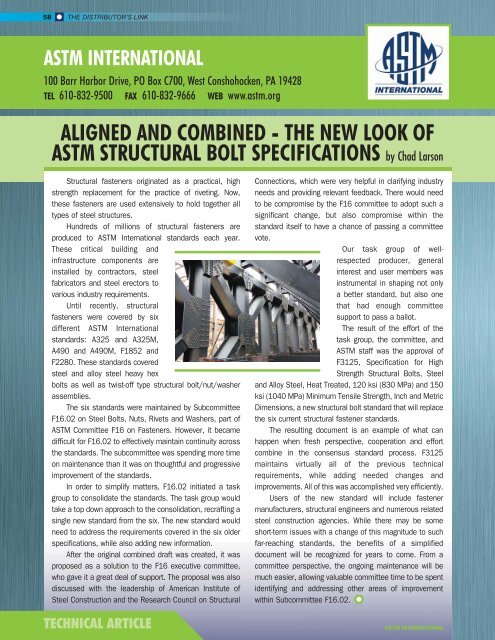WINTER 2016
Distributor's Link Magazine Winter Issue 2016 / Vol 39 No1
Distributor's Link Magazine Winter Issue 2016 / Vol 39 No1
Create successful ePaper yourself
Turn your PDF publications into a flip-book with our unique Google optimized e-Paper software.
58 THE DISTRIBUTOR’S LINK<br />
ASTM INTERNATIONAL<br />
100 Barr Harbor Drive, PO Box C700, West Conshohocken, PA 19428<br />
TEL 610-832-9500 FAX 610-832-9666 WEB www.astm.org<br />
ALIGNED AND COMBINED - THE NEW LOOK OF<br />
ASTM STRUCTURAL BOLT SPECIFICATIONS by Chad Larson<br />
Structural fasteners originated as a practical, high<br />
strength replacement for the practice of riveting. Now,<br />
these fasteners are used extensively to hold together all<br />
types of steel structures.<br />
Hundreds of millions of structural fasteners are<br />
produced to ASTM International standards each year.<br />
These critical building and<br />
infrastructure components are<br />
installed by contractors, steel<br />
fabricators and steel erectors to<br />
various industry requirements.<br />
Until recently, structural<br />
fasteners were covered by six<br />
different ASTM International<br />
standards: A325 and A325M,<br />
A490 and A490M, F1852 and<br />
F2280. These standards covered<br />
steel and alloy steel heavy hex<br />
bolts as well as twist-off type structural bolt/nut/washer<br />
assemblies.<br />
The six standards were maintained by Subcommittee<br />
F16.02 on Steel Bolts, Nuts, Rivets and Washers, part of<br />
ASTM Committee F16 on Fasteners. However, it became<br />
difficult for F16.02 to effectively maintain continuity across<br />
the standards. The subcommittee was spending more time<br />
on maintenance than it was on thoughtful and progressive<br />
improvement of the standards.<br />
In order to simplify matters, F16.02 initiated a task<br />
group to consolidate the standards. The task group would<br />
take a top down approach to the consolidation, recrafting a<br />
single new standard from the six. The new standard would<br />
need to address the requirements covered in the six older<br />
specifications, while also adding new information.<br />
After the original combined draft was created, it was<br />
proposed as a solution to the F16 executive committee,<br />
who gave it a great deal of support. The proposal was also<br />
discussed with the leadership of American Institute of<br />
Steel Construction and the Research Council on Structural<br />
TECHNICAL ARTICLE<br />
Connections, which were very helpful in clarifying industry<br />
needs and providing relevant feedback. There would need<br />
to be compromise by the F16 committee to adopt such a<br />
significant change, but also compromise within the<br />
standard itself to have a chance of passing a committee<br />
vote.<br />
Our task group of wellrespected<br />
producer, general<br />
interest and user members was<br />
instrumental in shaping not only<br />
a better standard, but also one<br />
that had enough committee<br />
support to pass a ballot.<br />
The result of the effort of the<br />
task group, the committee, and<br />
ASTM staff was the approval of<br />
F3125, Specification for High<br />
Strength Structural Bolts, Steel<br />
and Alloy Steel, Heat Treated, 120 ksi (830 MPa) and 150<br />
ksi (1040 MPa) Minimum Tensile Strength, Inch and Metric<br />
Dimensions, a new structural bolt standard that will replace<br />
the six current structural fastener standards.<br />
The resulting document is an example of what can<br />
happen when fresh perspective, cooperation and effort<br />
combine in the consensus standard process. F3125<br />
maintains virtually all of the previous technical<br />
requirements, while adding needed changes and<br />
improvements. All of this was accomplished very efficiently.<br />
Users of the new standard will include fastener<br />
manufacturers, structural engineers and numerous related<br />
steel construction agencies. While there may be some<br />
short-term issues with a change of this magnitude to such<br />
far-reaching standards, the benefits of a simplified<br />
document will be recognized for years to come. From a<br />
committee perspective, the ongoing maintenance will be<br />
much easier, allowing valuable committee time to be spent<br />
identifying and addressing other areas of improvement<br />
within Subcommittee F16.02.<br />
ASTM INTERNATIONAL

















